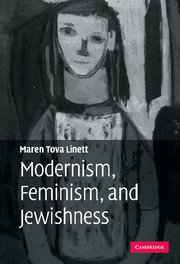Book contents
- Frontmatter
- Contents
- Acknowledgments
- List of abbreviations
- Introduction: imagined Jews and the shape of feminist modernism
- 1 “Strip each statement of its money motive”: Jews and the ideal of disinterested art in Warner, Rhys, and Woolf
- 2 Transformations of supersessionism in Woolf and Richardson
- 3 Adding bathrooms, fomenting revolutions: modernity and Jewishness in Woolf and Warner
- 4 The race must go on: gender, Jewishness, and racial continuity in Barnes and Richardson
- 5 The “No time region”: time, trauma, and Jewishness in Barnes and Rhys
- 6 Metatextual Jewishness: shaping feminist modernism
- Notes
- Works cited
- Index
Introduction: imagined Jews and the shape of feminist modernism
Published online by Cambridge University Press: 22 September 2009
- Frontmatter
- Contents
- Acknowledgments
- List of abbreviations
- Introduction: imagined Jews and the shape of feminist modernism
- 1 “Strip each statement of its money motive”: Jews and the ideal of disinterested art in Warner, Rhys, and Woolf
- 2 Transformations of supersessionism in Woolf and Richardson
- 3 Adding bathrooms, fomenting revolutions: modernity and Jewishness in Woolf and Warner
- 4 The race must go on: gender, Jewishness, and racial continuity in Barnes and Richardson
- 5 The “No time region”: time, trauma, and Jewishness in Barnes and Rhys
- 6 Metatextual Jewishness: shaping feminist modernism
- Notes
- Works cited
- Index
Summary
In Virginia Woolf's The Years (1937), Eleanor Pargiter describes her philanthropic work with a poor Jewish family, the Levys. She tells her younger sister Milly that “ ‘Mrs. Levy had her rent ready, for a wonder. … Lily helps her. Lily's got a job at a tailor's in Shoreditch. She came in all covered with pearls and things. They do love finery, Jews’ ” (Years 31). Eleanor's description trades in mild turn-of-the-century stereotypes: the Jewish daughter works for a tailor; she dutifully contributes to the rent; and she ostentatiously displays what little wealth she has. But the stereotypes are uninteresting compared with Milly's response to her sister's narrative. “ ‘Jews?’ said Milly. She seemed to consider the taste of the Jews; and then to dismiss it.” With this response Woolf's text leaves the mundane level of stereotype and presents a compelling moment of half-expressed meaning. Milly knows the Levys are Jews; she has heard about them before. But she nevertheless responds to Eleanor's generalization by repeating the word “Jews” interrogatively. Considering “the taste of the Jews” may literally mean considering Jews' taste in “finery.” But Milly also seems to be considering the taste of the word or category “Jews.” The text hints here that there is something more to consider than Eleanor's vacuous generalization: some intrinsic quality of Jewness, its essence in the sense of an extract, a concentrated form of a scent or flavor.
- Type
- Chapter
- Information
- Modernism, Feminism, and Jewishness , pp. 1 - 31Publisher: Cambridge University PressPrint publication year: 2007



